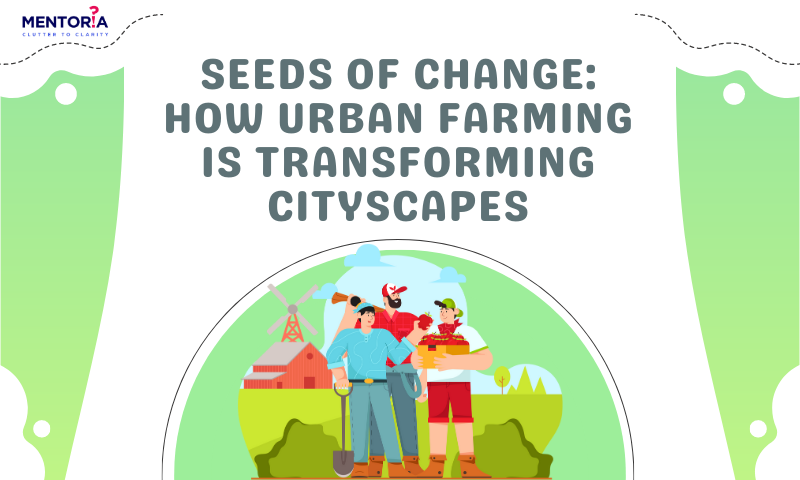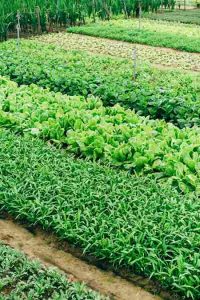Seeds Of Change: How Urban Farming Is Transforming Cityscapes

Amidst the cacophony of honking horns and bustling crowds, a quiet revolution is taking root in the heart of our cities. As the world grapples with the urgent need for sustainable food production and environmental stewardship, urban farming has emerged as a compelling solution. From vacant lots transformed into lush gardens to rooftops adorned with flourishing crops, the concrete jungle is giving way to a verdant oasis. This transformation not only reconnects urban dwellers with nature but also holds the promise of a more resilient and self-sufficient future. In this blog, we’ll delve into the fascinating world of urban farming, exploring its benefits, innovative techniques, community connections, success stories, and the remarkable impact it’s having on our cities. So, grab your gardening gloves and join us on this exciting journey!
The Blooming Benefits Of Urban Farming
Urban farming offers a myriad of benefits that positively impact individuals, communities, and the environment. First and foremost, it addresses food security by providing access to fresh, nutritious food in areas where traditional agriculture may be limited. By growing food locally, urban farmers reduce dependence on distant food sources and mitigate the environmental impact of long-distance transportation.
Furthermore, urban farming promotes sustainability by utilising resource-efficient practices. Techniques like vertical farming and hydroponics optimise space utilisation, conserve water, and reduce the need for harmful pesticides. Urban farms also act as green spaces that improve air quality, mitigate urban heat islands, and enhance overall well-being. Additionally, the act of gardening and being close to nature can have therapeutic effects on mental health, fostering a sense of connection and relaxation.
Innovative Farming Techniques Taking Root
Urban farming thrives on innovative techniques that adapt traditional agricultural practices to fit the constraints of city living. One such technique is vertical farming, where crops are grown in stacked layers, maximising space efficiency. Vertical farms utilise hydroponics or aeroponics, where plants grow without soil, receiving nutrients through water or mist. This method allows for year-round cultivation and increased crop yields. The global vertical farming market is expected to grow from $2.7 billion in 2021 to $11.7 billion by 2028.
Rooftop gardens are another popular approach in urban farming, transforming underutilised spaces into lush green sanctuaries. These gardens utilise container gardening, raised beds, or green roofs to cultivate a variety of fruits, vegetables, and herbs. Rooftop gardens not only provide fresh produce but also contribute to the insulation and energy efficiency of buildings while reducing stormwater runoff. The global rooftop garden market is expected to grow from $3.2 billion in 2021 to $7.6 billion by 2028.
Hydroponics, a soil-less growing method, is gaining traction in urban farming. It involves cultivating plants in nutrient-rich water, allowing for precise control over nutrient delivery and water usage. Hydroponics systems can be implemented indoors or outdoors, making them suitable for a wide range of urban settings. The growth rate of urban farming in India is expected to be high. A 2021 report by the National Centre for Sustainable Agriculture found that the urban farming market in India is growing at a CAGR of 20%. The government of India has launched a number of initiatives to promote urban farming, including the Pradhan Mantri Krishi Sinchai Yojana (PMKSY) and the National Urban Farming Policy.
Cultivating Community Connections
Urban farming goes beyond the act of growing food; it cultivates strong community connections. Community gardens serve as gathering places where people of diverse backgrounds come together to nurture plants, share knowledge, and forge friendships. These spaces foster social interaction, promote a sense of ownership and pride, and provide opportunities for intergenerational learning.
In addition to community gardens, urban farms often organise farmers’ markets, creating vibrant spaces where locals can connect with farmers and purchase fresh, locally grown produce. These markets serve as a bridge between producers and consumers, fostering relationships and supporting the local economy. They also promote food education, encouraging healthy eating habits and showcasing the benefits of sustainable agriculture.
Urban farms are also catalysts for educational initiatives, providing opportunities for workshops, gardening classes, and environmental education programs. By engaging with schools and community organisations, urban farmers empower individuals with knowledge about sustainable farming practices, nutrition, and environmental stewardship.
Digging Into Success Stories
Across the globe, urban farming has inspired remarkable success stories that showcase its transformative power. One such example is Detroit, where vacant lots and abandoned buildings have been repurposed into thriving urban farms. These farms not only provide fresh food to underserved communities but also create jobs, revitalise neighbourhoods, and instil a sense of hope and pride.
Singapore, a densely populated city-state, has embraced urban farming as part of its vision for a sustainable future. Innovative projects like rooftop gardens, vertical farms, and community farms have enhanced food security and reduced dependence on food imports. These initiatives demonstrate that even in highly urbanised areas, it is possible to cultivate a significant portion of the city’s food needs.
Berlin, Germany, has transformed unused spaces into vibrant urban farms, contributing to the city’s vibrant food culture. From rooftop gardens to community-supported agriculture, Berlin’s urban farms provide fresh produce to local markets and restaurants while fostering community engagement. These farms have become symbols of sustainability, resilience, and self-sufficiency.
The Future Of Urban Farming
As urban farming continues to gain momentum, its future looks promising. Technological advancements, such as the integration of artificial intelligence and automation, hold the potential to revolutionise urban farming practices. Smart agriculture systems could monitor plant health, optimise resource utilisation, and further increase efficiency.
Furthermore, the integration of renewable energy sources like solar panels and wind turbines into urban farming infrastructure can enhance sustainability and reduce the carbon footprint. The use of vertical farms and green walls in urban planning can provide urban dwellers with access to fresh food, green spaces, and improved air quality.
Growing Green: How Mentoria Empowers Your Urban Farming Journey
From barren rooftops to once-vacant lots, urban farming is breathing new life into our cities. It’s a movement that goes beyond growing food; it’s about reconnecting with nature, fostering community, and building a sustainable future. As we’ve explored the benefits, innovative techniques, community connections, and success stories of urban farming, it’s clear that this movement is here to stay.
But where do you start on your journey to becoming an urban farming aficionado? That’s where Mentoria comes in. Our team of experts can provide you with the guidance, knowledge, and resources you need to navigate the world of urban farming and embark on your own green revolution. Whether it’s learning about vertical gardening techniques, understanding soil composition, or connecting with like-minded enthusiasts, Mentoria is here to support you every step of the way. So, don’t let the concrete jungle hold you back from cultivating your green oasis. Sign up for Mentoria today and join the movement that is transforming our cities, our food systems, and our connection to nature.









